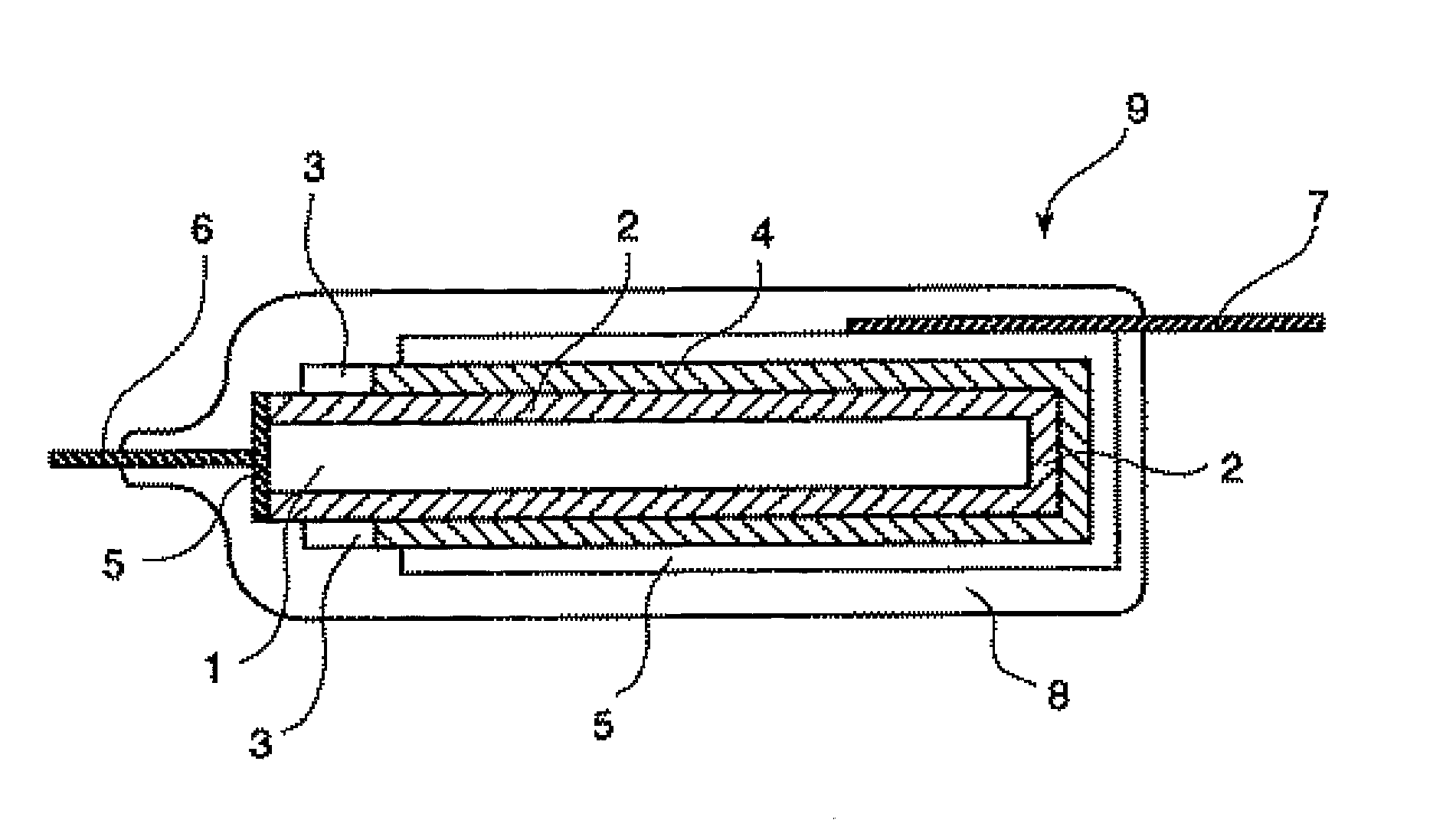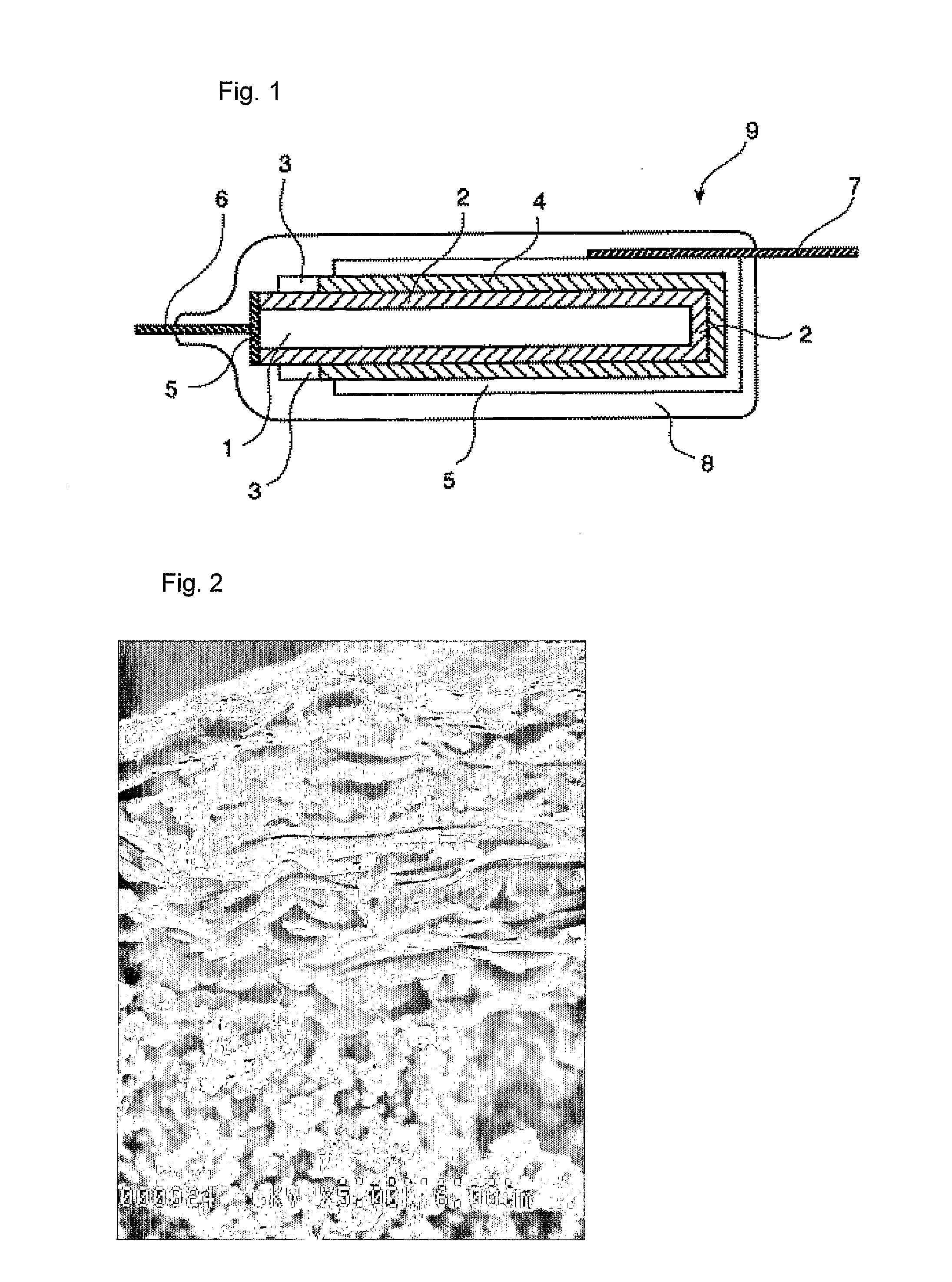Solid Electrolytic Capacitor and Method for Producing the Same
a solid electrolytic capacitor and capacitor chip technology, applied in the manufacture of electrolytic capacitors, capacitors, capacitors, etc., can solve the problems of increasing leakage current, large equivalent series resistance (esr), and increasing the capacitance of the solid electrolytic capacitor chip, so as to reduce the dielectric loss (tan ), high capacitance, and the effect of reducing the dielectric loss
- Summary
- Abstract
- Description
- Claims
- Application Information
AI Technical Summary
Benefits of technology
Problems solved by technology
Method used
Image
Examples
examples
[0100] The present invention is described in greater detail below by referring to representative examples, but these are mere examples for describing the present invention, and the present invention is not limited thereto. Example 1:
[0101] A chemically formed aluminum foil (thickness: 100 μm) was cut into a size of 3 mm (short axis direction)×10 mm (long axis direction), and a polyimide solution was circumferentially coated on both surfaces in a width of 1 mm to divide the surface into a 4-mm portion and a 5-mm portion in the long axis direction and then dried to provide a masking. A voltage of 4 V was applied to the 3 mm×4 mm portion of this chemically formed foil in a 10 mass % aqueous ammonium adipate solution to chemically form the cut end part and thereby produce a dielectric oxide film. Thereafter, this 3 mm×4 mm portion of the aluminum foil was dipped in a 2.0 mol / L isopropyl alcohol (IPA) solution having dissolved therein 3,4-ethylenedioxythiophene for 5 seconds and after d...
example 2
[0106] A chemically formed aluminum foil. (thickness: 100 μm) was cut into a size of 3 mm (short axis direction)×10 mm (long axis direction), and a polyimide solution was circumferentially coated on both surfaces in a width of 1 mm to divide the surface into a 4-mm portion and a 5-mm portion in the long axis direction and then dried to provide a masking. A voltage of 4 V was applied to the 3 mm×4 mm portion of this chemically formed foil in a 10 mass % aqueous ammonium adipate solution to chemically form the cut end part and thereby produce a dielectric oxide film. Thereafter, this 3 mm×4 mm portion of the aluminum foil was dipped in a 2.0 mol / L isopropyl alcohol (IPA) solution having dissolved therein 3,4-ethylenedioxythiophene for 5 seconds and after drying at room temperature for 5 minutes (Step 1), dipped in a 2.0 mol / L aqueous ammonium persulfate solution adjusted to have a sodium 2-anthraquinonesulfonate concentration of 0.07 mass % for 5 seconds. Subsequently, this aluminum f...
example 3
[0111] A solid electrolyte layer was formed in the same manner as in Example 1 except that in the dipping step in Step 3 of Example 1, a suspension prepared to have a sodium 2-anthraquinonesulfonate (D50=11 μm) concentration of 2 mass % was used in place of distilled water and the number of repetitions of Steps 1 to 3 was changed to 9 times. The residual ratio of the solid electrolyte determined by the same manner as in Example 1 was 79%. The thickness of the aluminum foil was measured in the same manner as in Example 1, as a result, the average film thickness of 120 elements was 146 μm and the standard deviation was 16 μ.
[0112] Thereafter, 30 units of capacitors were completed in the same manner as in Example 1. The properties of the obtained capacitor devices were evaluated in the same manner as in Example 1 and the results thereof are shown in Table 1.
PUM
| Property | Measurement | Unit |
|---|---|---|
| time | aaaaa | aaaaa |
| particle diameter | aaaaa | aaaaa |
| thickness | aaaaa | aaaaa |
Abstract
Description
Claims
Application Information
 Login to View More
Login to View More - R&D
- Intellectual Property
- Life Sciences
- Materials
- Tech Scout
- Unparalleled Data Quality
- Higher Quality Content
- 60% Fewer Hallucinations
Browse by: Latest US Patents, China's latest patents, Technical Efficacy Thesaurus, Application Domain, Technology Topic, Popular Technical Reports.
© 2025 PatSnap. All rights reserved.Legal|Privacy policy|Modern Slavery Act Transparency Statement|Sitemap|About US| Contact US: help@patsnap.com



